A Spatial Equilibrium Evaluation of Primary Education Services Based on Living Circle Models: A Case Study within the City of Zhangjiakou, Hebei Province, China
Abstract
:Highlights
- A new method is proposed to quantitatively assess the equilibrium between primary education facilities and primary students from the perspective of the living circle. The spatial equilibrium of primary education services across Zhangjiakou City was evaluated based on four living circle scenarios.
- We establish a site selection path to optimize the spatial equilibrium of primary education based on the living circle.
Abstract
1. Introduction
2. Study Area and Materials
2.1. Study Area
2.2. Data Sources and Processing
3. Methods
3.1. The Spatial Distribution of Primary Students
3.2. Living Circle Unit Construction
3.3. Equilibrium Evaluation Model
4. Results
4.1. The Spatial Distribution of Primary Students
4.2. Primary Student Statistics for Different Living Circles
4.3. Spatial Equilibrium Distribution Characteristics for Primary Education Services
5. Discussion
6. Conclusions
Author Contributions
Funding
Data Availability Statement
Acknowledgments
Conflicts of Interest
References
- Aldis, J. Strategic facility location, capacity acquisition, and technology choice decisions under demand uncertainty: Robust vs. non-robust optimization approaches. Eur. J. Oper. Res. 2017, 260, 1095–1104. [Google Scholar]
- Rohaninejad, M.; Navidi, H.; Nouri, B.V.; Kamranrad, R. A new approach to cooperative competition in facility location problems: Mathematical formulations and an approximation algorithm. Comp. Oper. Res. 2017, 83, 45–53. [Google Scholar] [CrossRef]
- Gao, Y.; He, Q.; Liu, Y.; Zhang, L.; Wang, H.; Cai, E. Imbalance in spatial accessibility to primary and secondary schools in China: Guidance for education sustainability. Sustainability 2016, 8, 1236. [Google Scholar] [CrossRef] [Green Version]
- National Bureau of Statistics. China Statistical Yearbook 2018; China Statistical Press: Beijing, China, 2018.
- Tian, L.; Tao, R. Land reform, housing guarantee, and transition of urban-rural development opportunities and challenges for developing rental housing in collective land. City Plan. 2019, 43, 53–60. [Google Scholar]
- Liu, Y.; Li, Y. Revitalize the worlds countryside. Nature 2017, 548, 275–277. [Google Scholar] [CrossRef] [PubMed] [Green Version]
- Xiao, Z.P.; Cai, Y.W.; Zhang, Y. Overseas life circle planning and practice. Planners 2014, 30, 89–95. [Google Scholar]
- Fan, C.; Zhai, G.; Zhou, S.; Zhang, H.; Qiao, P. Integrated framework for emergency shelter planning based on multihazard risk evaluation and its application: Case study in China. Nat. Hazards Rev. 2017, 18, 1–15. [Google Scholar] [CrossRef]
- Masateru, H. Progress of Japanese urban geography after the 1950ps and new directions. Urban Reg. Plan. Res. 2010, 3, 118–131. [Google Scholar]
- Zhu, Y.R. The development of residential district planning in Korea and its enlightenments. Urban Plan. Int. 2009, 24, 106–110. [Google Scholar]
- Duan, J. Building a Defense Unit in the Space Planning System: A Workshop on 2020 COVID-19 Emergencies [EB/OL]. Available online: http://kns.cnki.net/kcms/detail/11.2378.TU.20200220.1353.002.html (accessed on 21 February 2020).
- Yeager, R.F. Rationality and retrenchment: The use of a computer simulation to Aid decision making in school closings. Educ. Urban Soc. 1979, 11, 296–312. [Google Scholar] [CrossRef]
- Bennett, D.L. Educational inequality in the United States: Methodology and historical estimation of education Gini coefficients. Soc. Sci. Res. Netw. 2011, 33, 1–34. [Google Scholar]
- Brousselle, A.; Petit, G.; Giraud, M.J.; Rietmann, M.; Boisvert, K.; Foley, V. Using the evaluation process as a lever for improving health and healthcare accessibility: The case of HCV services organization in Quebec. Eval. Program Plan. 2016, 55, 134–143. [Google Scholar] [CrossRef] [Green Version]
- Takahagi, W.; Sumitani, Y.; Takahashi, H.; Omae, Y.; Sakai, K. Method of determining future facility location with maintaining present accessibility. Ind. Eng. Manag. Syst. 2016, 15, 197–205. [Google Scholar] [CrossRef] [Green Version]
- Taylor, R.G.; Vasu, M.L.; Causby, J.F. Integrated planning for school and community: The case of johnston county, north carolina. Interfaces 1999, 29, 67–89. [Google Scholar] [CrossRef]
- Slagle, M. GIS in community-based school planning: A tool to enhance decision making, cooperation, and democratization in the planning process. EDRS PRICE 2000, 16–19. Available online: https://aap.cornell.edu/academics/department-city-and-regional-planning (accessed on 21 February 2022).
- Gao, J.B.; Zhou, C.S.; Wang, Y.M.; Jiang, H. Spatial analysis on urban public service facilities of Guangzhou City during the economy system transformation. Geogr. Res. 2011, 30, 424–436. [Google Scholar]
- Zhu, H.H.; Yan, H.W.; Li, Y.L. An optimization method for the layout of public service facilities based on Voronoi diagrams. Sci. Surv. Mapp. 2008, 33, 72–74. [Google Scholar]
- Pablo, C.B.; Wei, C.; Michael, H. Multiscale evaluation of an urban deprivation index: Implications for quality of life and healthcare accessibility planning. Appl. Geogr. 2016, 70, 1–10. [Google Scholar]
- Xiao, F.L.; Du, R.H.; Zhang, X.L. Evaluation of spatial allocation of residential quarters and public service facilities based on the perspective of 15 minutes life circle: A case study of Urumqi. Arid. Land Geogr. 2021, 44, 7565. [Google Scholar]
- Zhang, X.K.; Pei, X.R.; Li, J.R.; Zeng, P. Spatial differences of public service facilities in central urban area of Tianjin from the perspective of life circle. J. Arid. Land Resour. Environ. 2021, 35, 43–51. [Google Scholar]
- Wei, W.; Hong, M.Y.; Xie, B. Demand-supply matching oriented 15-minute community life circle demarcation and spatial optimization, Wuhan. Planner 2019, 35, 11–17. [Google Scholar]
- Sun, P.; Xu, Y.; Yu, Z.; Liu, Q.; Xie, B.; Liu, J. Scenario simulation and landscape pattern dynamic changes of land use in the Poverty Belt around Beijing and Tianjin: A case study of Zhangjiakou city, Hebei Province. J. Geogr. Sci. 2016, 26, 272–296. [Google Scholar] [CrossRef]
- Zhangjiakou People’s Government Office. Zhangjiakou Economic Yearbook-2018; China Statistics Press: Beijing, China, 2018.
- Huang, A.; Xu, Y.; Sun, P.; Zhou, G.; Liu, C.; Lu, L.; Xiang, Y.; Wang, H. Land use/land cover changes and its impact on ecosystem services in ecologically fragile zone: A case study of Zhangjiakou City, Hebei Province, China. Ecol. Indic. 2019, 104, 604–614. [Google Scholar] [CrossRef]
- Olubadewo, O.O.; Abdulkarim, I.A.; Ahmed, M. The use of GIS as educational decision support system(EDSS) for primary schools in Fagge local government area of Kano state, Nigeria. Acad. Res. Int. 2013, 6, 614–625. [Google Scholar]
- Huang, A.; Xu, Y.; Sun, P.; Liu, C.; Zheng, W. Spatial distribution of population spatialization based on multi-source data: A case study of Zhangjiakou city. Resour. Sci. 2017, 39, 2186–2196. [Google Scholar]
- Cao, X.; Hu, Y.; Zhu, X.; Shi, F.; Zhuo, L.; Chen, J. A simple self-adjusting model for correcting the blooming effects in DMSP-OLS nighttime light images. Remote Sens. Environ. 2019, 224, 401–411. [Google Scholar] [CrossRef]
- He, M.; Xu, Y.; Li, N. Population spatialization in Beijing City based on machine learning and multisource remote sensing data. Remote Sens. 2020, 12, 1910. [Google Scholar] [CrossRef]
- Tan, C.; Tang, Y.; Wu, X. Evaluation of the equity of urban park green space based on population data spatialization: A case study of a central area of Wuhan, China. Sensors 2019, 19, 2929. [Google Scholar] [CrossRef] [Green Version]
- Xiong, J.; Li, K.; Cheng, W.; Ye, C.; Zhang, H. A method of population spatialization considering parametric spatial stationarity: Case study of the southwestern area of China. ISPRS Int. J. Geo-Inf. 2019, 8, 495. [Google Scholar] [CrossRef] [Green Version]
- Liang, H.; Ren, J.; Dong, L.; Gao, Z.; Zhang, N.; Pan, M. Is the hydrogen production from biomass technology really sustainable? Answer by life cycle emergy analysis. Int. J. Hydrog. Energy 2016, 41, 10507–10514. [Google Scholar] [CrossRef]
- González-Quintero, R.; Bolívar-Vergara, D.M.; Chirinda, N.; Arango, J.; Pantevez, H.; Barahona-Rosales, R.; Sánchez-Pinzón, M.S. Environmental impact of primary beef production chain in Colombia: Carbon footprint, non-renewable energy and land use using life cycle assessment. Sci. Total Environ. 2021, 773, 145573. [Google Scholar] [CrossRef]
- Han, Y.H.; Lu, Y.Q. Accessibility assessment and planning of public service facilities for education: A Case study on senior high schools in Yizheng City. Sci. Geogr. Sin. 2012, 7, 822–827. [Google Scholar]
- Dos Anjos Luis, A.; Cabral, P. Geographic accessibility to primary healthcare centers in Mozambique. Int. J. Equity Health 2016, 15, 173–185. [Google Scholar] [CrossRef] [PubMed] [Green Version]
- Ertugay, K.; Argyroudis, S.; Düzgün, H.S. Accessibility modeling in earthquake case considering road closure probabilities: A case study of health and shelter service accessibility in Thessaloniki, Greece. Int. J. Disaster Risk Reduct. 2016, 17, 49–66. [Google Scholar] [CrossRef]
- Featherstone, P.; Eberth, J.M.; Nitcheva, D.; Liu, J. Geographic accessibility to health services and neonatal mortality among very-low birthweight infants in south Carolina. Matern. Child Health J. 2016, 20, 2382–2391. [Google Scholar] [CrossRef] [PubMed]
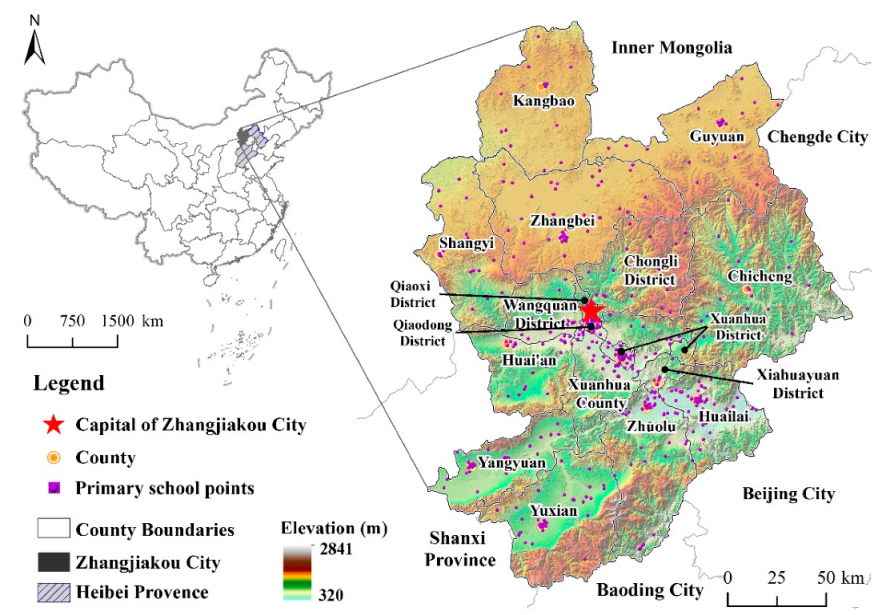
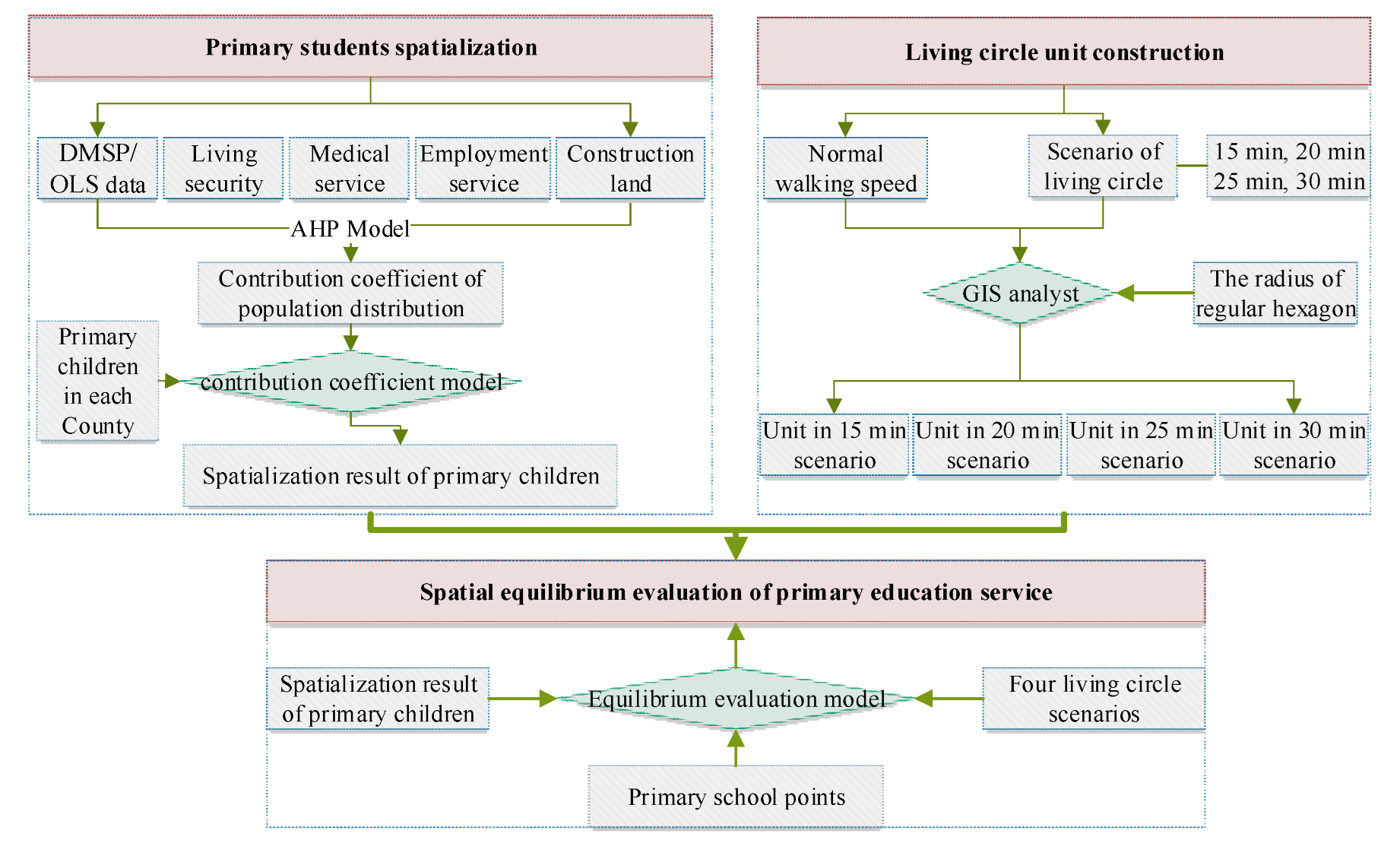
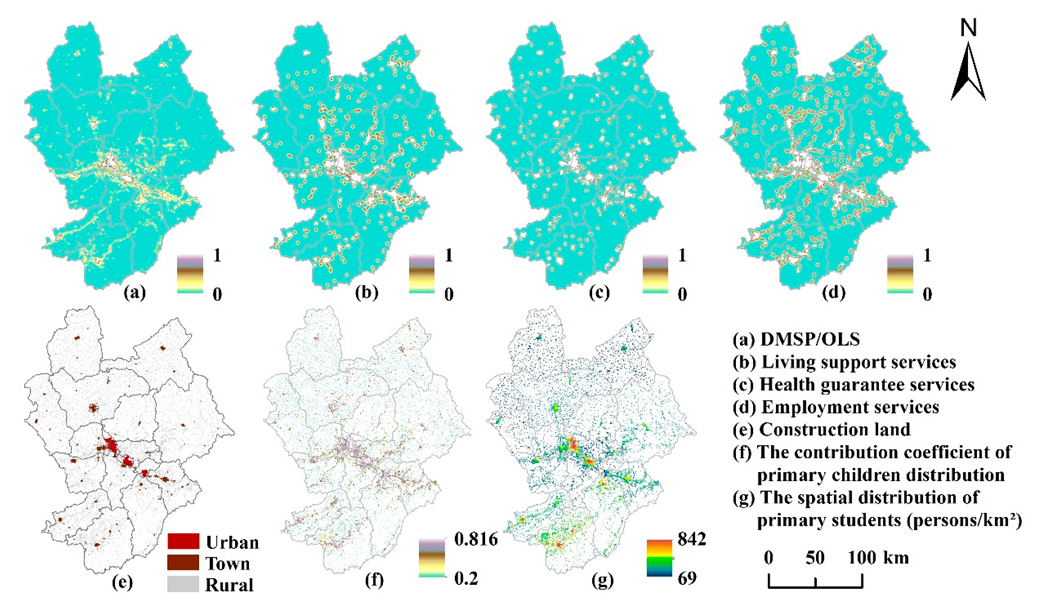

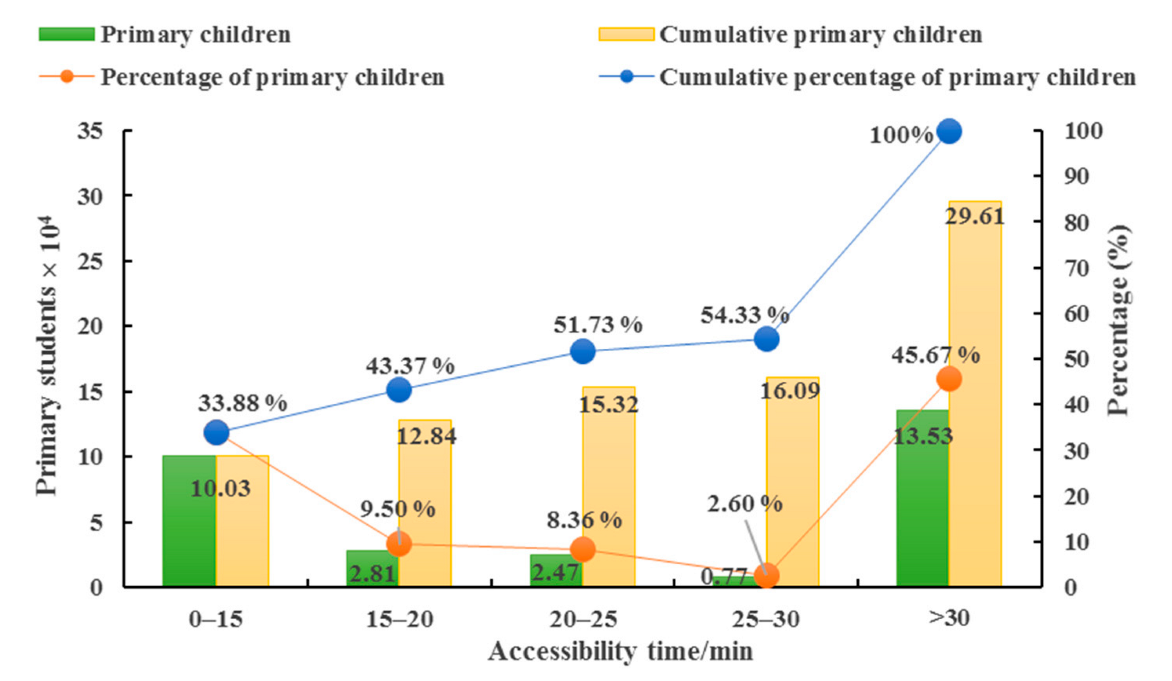
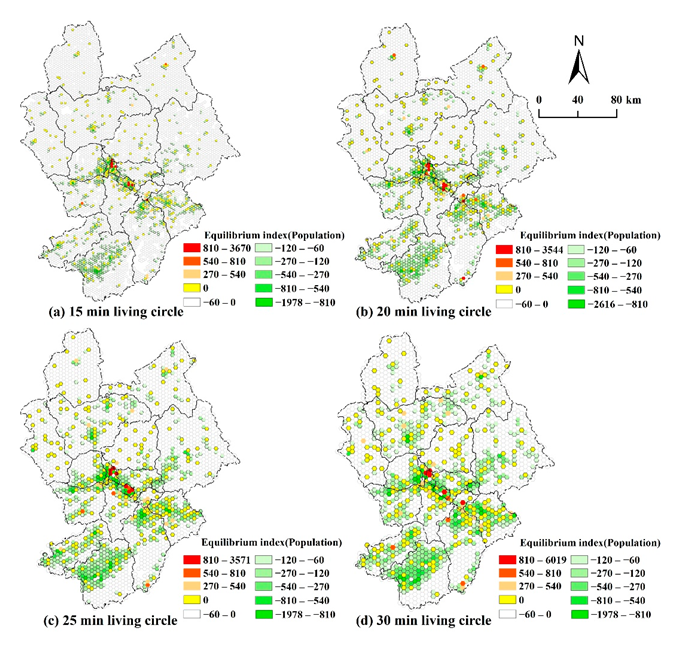

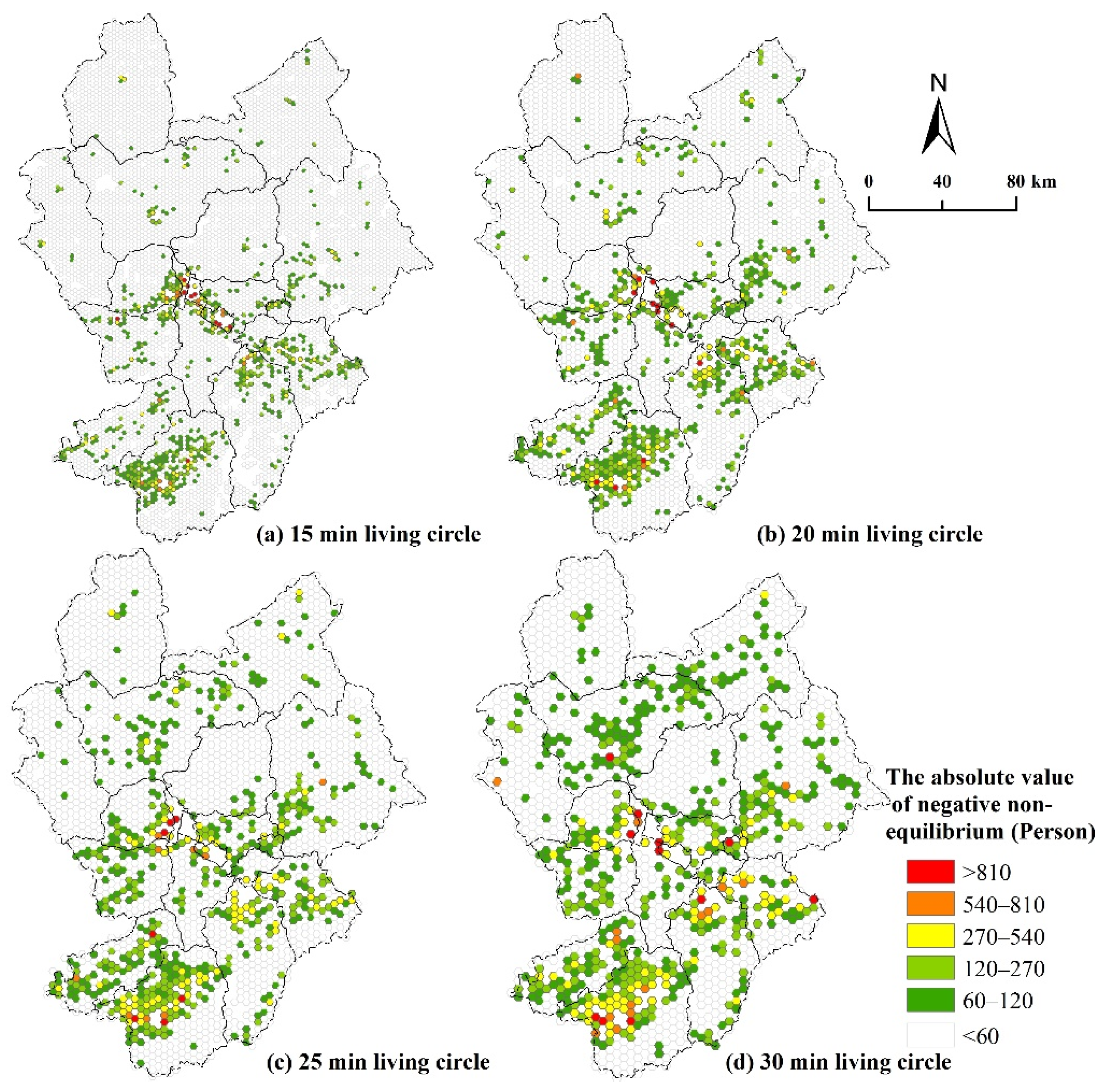
| First-Tier Variable | Second-Tier Variable | Method |
|---|---|---|
| DMSP/OLS | -- | Normalized to 0~1 based on the formula , where F(x) is the normalized value, x is the original data, xmin is the minimum value of x, and xmax is the maximum value of x. |
| Living support services | Supermarket accessibility Farmers market accessibility Bus stop accessibility Catering services | The accessibility of each service was first calculated based on POI data and the Euclidean Distance Analysis tool in ArcGIS 10.4.1 (created by ESRI company, in RedLands, California, USA). Second, accessibility distance was divided into 11 levels: up to 200 m, between 200 m and 400 m, between 400 m and 600 m, between 600 m and 800 m, and greater than 2000 m. The contribution value for different levels was assigned via the expert scoring method on the scale 1, 0.9, 0.8, 0.7... 0. |
| Health guarantee services | General hospital accessibility Special hospital accessibility Clinic accessibility | |
| Employment services | Company accessibility Factory accessibility | |
| Construction land | A contribution value for different areas was assigned using the expert scoring method. | |
| Urban | 0.5 | |
| Town | 0.3 | |
| Rural | 0.1 |
| Living Circle (Minutes) | Normal Walking Speed (m/s) | Regular Hexagon Radius (m) | Regular Hexagon Area (m2) |
|---|---|---|---|
| 15 | 1.418 | 1276.2 | 4,231,327.371 |
| 20 | 1.418 | 1701.6 | 7,522,359.771 |
| 25 | 1.418 | 2127 | 11,753,687.14 |
| 30 | 1.418 | 2552.4 | 16,925,309.48 |
| Level | 15 min | 20 min | 25 min | 30 min | ||||
|---|---|---|---|---|---|---|---|---|
| Count | Ratio/% | Count | Ratio/% | Count | Ratio/% | Count | Ratio/% | |
| (810, +∞] | 9 | 0.13 | 9 | 0.20 | 7 | 0.23 | 5 | 0.23 |
| (540, 810] | 2 | 0.03 | 6 | 0.13 | 4 | 0.13 | 4 | 0.18 |
| (270, 540] | 27 38 | 0.39 | 22 35 | 0.49 | 20 31 | 0.66 | 19 28 | 0.87 |
| 0 | 278 | 4.01 | 255 | 5.72 | 232 | 7.66 | 214 | 9.82 |
| [−60,0) | 5878 | 84.77 | 3477 | 78.03 | 2152 | 71.05 | 1357 | 62.28 |
| [−120, −60) | 399 | 5.75 | 346 | 7.76 | 284 | 9.38 | 280 | 12.85 |
| [−270, −120) | 219 | 3.16 | 222 | 4.98 | 194 | 6.40 | 158 | 7.25 |
| [−540, −270) | 75 | 1.08 | 77 | 1.73 | 85 | 2.81 | 91 | 4.18 |
| [−810, −540) | 24 | 0.35 | 16 | 0.36 | 19 | 0.63 | 22 | 1.01 |
| [−∞, −810) | 23 | 0.33 | 26 | 0.58 | 32 | 1.06 | 29 | 1.33 |
| Total | 6934 | 100 | 4456 | 100 | 3029 | 100 | 2179 | 100 |
| Containing primary schools | 15 min | 20 min | 25 min | 30 min | ||||
| Count | Ratio/% | Count | Ratio/% | Count | Ratio/% | Count | Ratio/% | |
| [−60, 0) | 0 | 0 | 0 | 0 | 0 | 0 | 0 | 0 |
| [−120, −60) | 0 | 0 | 0 | 0 | 0 | 0 | 0 | 0 |
| [−270, −120) | 0 | 0 | 0 | 0 | 0 | 0 | 0 | 0 |
| [−540, −270) | 11 | 0.16 | 17 | 0.38 | 13 | 0.43 | 19 | 0.87 |
| [−810, −540) | 8 | 0.12 | 5 | 0.11 | 10 | 0.33 | 7 | 0.32 |
| [−∞, −810) | 13 | 0.19 | 15 | 0.34 | 25 | 0.83 | 18 | 0.83 |
| Lacking primary schools | 15 min | 20 min | 25 min | 30 min | ||||
| Count | Ratio/% | Count | Ratio/% | Count | Ratio/% | Count | Ratio/% | |
| [−60, 0) | 5878 | 84.77 | 3477 | 78.03 | 2152 | 71.05 | 1357 | 62.28 |
| [−120, −60) | 399 | 5.75 | 346 | 7.76 | 284 | 9.38 | 280 | 12.85 |
| [−270, −120) | 219 | 3.16 | 222 | 4.98 | 194 | 6.40 | 158 | 7.25 |
| [−540, −270) | 64 | 0.92 | 60 | 1.35 | 72 | 2.38 | 72 | 3.30 |
| [−810, −540) | 16 | 0.23 | 11 | 0.25 | 9 | 0.30 | 15 | 0.69 |
| [−∞, −810) | 10 | 0.14 | 11 | 0.25 | 7 | 0.23 | 11 | 0.50 |
| Planning Proposals | Equilibrium Index (Person) | Living Circle Counts | Legends | |||
|---|---|---|---|---|---|---|
| 15 min | 20 min | 25 min | 30 min | |||
| A complete primary school should be planned in the center of the living circle. | >810 | 10 | 11 | 7 | 11 |  |
| 540–810 | 16 | 11 | 9 | 15 | ||
| 270–540 | 64 | 60 | 72 | 72 | ||
| Subtotal | 90 | 82 | 88 | 98 | ||
| An incomplete primary school should be planned in the center of the living circle. | 120–270 | 219 | 222 | 194 | 158 | |
| A complete or incomplete primary school should be planned at the junction between two or three living circles. | 60–120 | 399 | 346 | 284 | 280 |  |
| Boarding with other living circles containing primary schools. | <60 | 5878 | 3477 | 2152 | 1357 | -- |
Publisher’s Note: MDPI stays neutral with regard to jurisdictional claims in published maps and institutional affiliations. |
© 2022 by the authors. Licensee MDPI, Basel, Switzerland. This article is an open access article distributed under the terms and conditions of the Creative Commons Attribution (CC BY) license (https://creativecommons.org/licenses/by/4.0/).
Share and Cite
Huang, A.; Xu, Y.; Zhang, Y.; Lu, L.; Liu, C.; Sun, P.; Liu, Q. A Spatial Equilibrium Evaluation of Primary Education Services Based on Living Circle Models: A Case Study within the City of Zhangjiakou, Hebei Province, China. Land 2022, 11, 1994. https://doi.org/10.3390/land11111994
Huang A, Xu Y, Zhang Y, Lu L, Liu C, Sun P, Liu Q. A Spatial Equilibrium Evaluation of Primary Education Services Based on Living Circle Models: A Case Study within the City of Zhangjiakou, Hebei Province, China. Land. 2022; 11(11):1994. https://doi.org/10.3390/land11111994
Chicago/Turabian StyleHuang, An, Yueqing Xu, Yibin Zhang, Longhui Lu, Chao Liu, Piling Sun, and Qingguo Liu. 2022. "A Spatial Equilibrium Evaluation of Primary Education Services Based on Living Circle Models: A Case Study within the City of Zhangjiakou, Hebei Province, China" Land 11, no. 11: 1994. https://doi.org/10.3390/land11111994
APA StyleHuang, A., Xu, Y., Zhang, Y., Lu, L., Liu, C., Sun, P., & Liu, Q. (2022). A Spatial Equilibrium Evaluation of Primary Education Services Based on Living Circle Models: A Case Study within the City of Zhangjiakou, Hebei Province, China. Land, 11(11), 1994. https://doi.org/10.3390/land11111994





